How to Install LAMP Stack on Debian 10 Buster Server/Desktop
This tutorial is going to show you how to install Apache, MariaDB and PHP7.3 (LAMP stack) on Debian 10 Buster. A software stack is a set of software tools bundled together. LAMP stands for Linux, Apache, MariaDB/MySQL and PHP, all of which are open source and free to use. It is the most common software stack that powers dynamic websites and web applications. Linux is the operating system; Apache is the web server; MariaDB/MySQL is the database server and PHP is the server-side scripting language responsible for generating dynamic web pages.
All of the four components are free and open-source. However, since MySQL is now owned by Oracle and there’s a chance that Oracle turns it to a closed-source product, we will choose MariaDB instead of MySQL.
Prerequisites of Installing LAMP Stack on Debian 10 Buster
To follow this tutorial, you need a Debian 10 OS running on your local computer or on a remote server.
If you are looking for a VPS (Virtual Private Server), then you can register an account at Vultr via this special link to get $50 free credit (for new users only). And if you need to set up LAMP stack with a domain name, I recommend buying domain names from NameCheap because the price is low and they give whois privacy protection for free.
Please note that you need to have root privilege when installing software on Debian. You can add sudo at the beginning of a command, or use su - command to switch to root user.
Step 1: Update Software Packages
Before we install the LAMP stack, it’s a good idea to update repository and software packages. Run the following command on your Debian 10 OS.
sudo apt update sudo apt upgrade
Step 2: Install Apache Web Server on Debian 10
Enter the following command to install Apache Web server. The apache2-utils package will install some useful utilities, such as the Apache HTTP server benchmarking tool ab and the user authentication management tool htpasswd.
sudo apt install apache2 apache2-utils
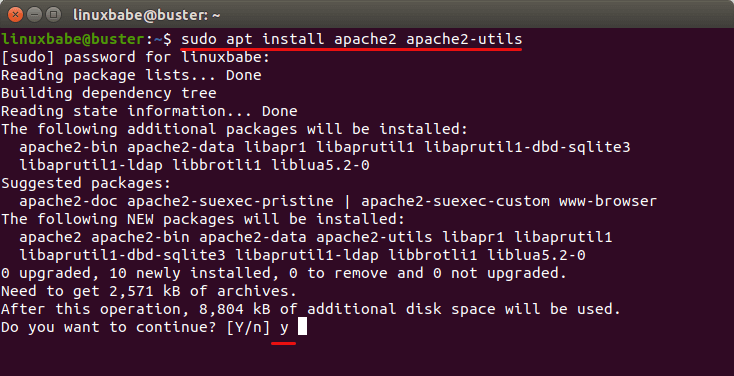
After it’s installed, Apache should be automatically started. Check its status with systemctl.
systemctl status apache2
Sample output:
● apache2.service - The Apache HTTP Server Loaded: loaded (/lib/systemd/system/apache2.service; enabled; vendor preset: enabled) Active: active (running) since Thu 2019-07-11 13:30:35 UTC; 4min 31s ago Docs: https://httpd.apache.org/docs/2.4/ Process: 17962 ExecStart=/usr/sbin/apachectl start (code=exited, status=0/SUCCESS) Main PID: 17966 (apache2) Tasks: 55 (limit: 545) Memory: 4.8M CGroup: /system.slice/apache2.service ├─17966 /usr/sbin/apache2 -k start ├─17967 /usr/sbin/apache2 -k start └─17968 /usr/sbin/apache2 -k start
If it’s not running, use systemctl to start it.
sudo systemctl start apache2
It’s also a good idea to enable Apache to automatically start at boot time.
sudo systemctl enable apache2
Check Apache version:
sudo apache2 -v
Output:
Server version: Apache/2.4.38 (Debian) Server built: 2019-04-07T18:15:40
Now type in the public IP address of your Debian 10 server in the browser address bar. You should see “It works!” Web page, which means Apache Web server is running properly. If you are installing LAMP on your local Debian 10 computer, then you should type 127.0.0.1 or localhost in the browser address bar.
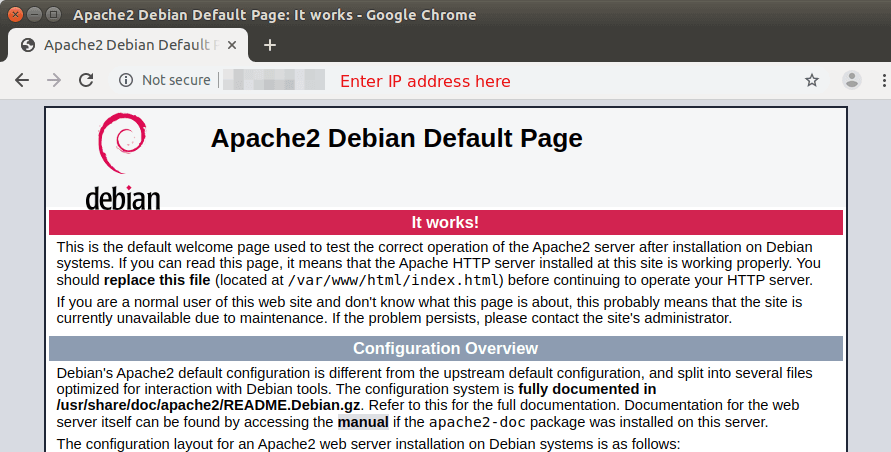
If the connection is refused or failed to complete, there might be a firewall preventing incoming requests to TCP port 80. If you are using iptables firewall, then you need to run the following command to open TCP port 80.
sudo iptables -I INPUT -p tcp --dport 80 -j ACCEPT
If you are using UFW firewall, then run this command to open TCP port 80.
sudo ufw allow http
Now we need to set www-data (Apache user) as the owner of document root (otherwise known as web root). By default it’s owned by the root user.
sudo chown www-data:www-data /var/www/html/ -R
By default, Apache uses the system hostname as its global ServerName. If the system hostname can’t be resolved in DNS, then you will probably see the following error after running sudo apache2ctl -t command.
AH00558: apache2: Could not reliably determine the server's fully qualified domain name, using 127.0.0.1. Set the 'ServerName' directive globally to suppress this message
To solve this problem, we can set a global ServerName in Apache. Use the Nano command-line text editor to create a new configuration file.
sudo nano /etc/apache2/conf-available/servername.conf
Add the following line in this file.
ServerName localhost
Save and close the file. To save a file in Nano text editor, press Ctrl+O, then press Enter to confirm. To exit, press Ctrl+X. Then enable this config file.
sudo a2enconf servername.conf
Reload Apache for the change to take effect.
sudo systemctl reload apache2
Now if you run the sudo apache2ctl -t command again, you won’t see the above error message.
Step 3: Install MariaDB Database Server on Debian 10
MariaDB is a drop-in replacement for MySQL. Enter the following command to install it on Debian 10.
sudo apt install mariadb-server mariadb-client
After it’s installed, MariaDB server should be automatically stared. Use systemctl to check its status.
systemctl status mariadb
Output:
● mariadb.service - MariaDB 10.3.15 database server Loaded: loaded (/lib/systemd/system/mariadb.service; enabled; vendor preset: enabled) Active: active (running) since Thu 2019-07-11 13:57:03 UTC; 16s ago Docs: man:mysqld(8) https://mariadb.com/kb/en/library/systemd/ Main PID: 18566 (mysqld) Status: "Taking your SQL requests now..." Tasks: 31 (limit: 545) Memory: 73.9M CGroup: /system.slice/mariadb.service └─18566 /usr/sbin/mysqld
If it’s not running, start it with this command:
sudo systemctl start mariadb
To enable MariaDB to automatically start at boot time, run
sudo systemctl enable mariadb
Now run the post installation security script.
sudo mysql_secure_installation
When it asks you to enter MariaDB root password, press Enter key as the root password isn’t set yet. Then enter y to set the root password for MariaDB server.
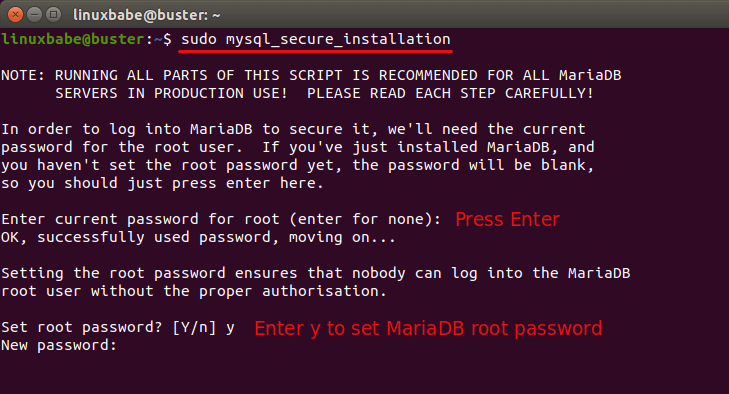
Next, you can just press Enter to answer all remaining questions. This will remove anonymous user, disable remote root login and remove test database. This step is a basic requirement for MariaDB database security. (Note that the letter Y is capitalized, which means it’s the default answer.)
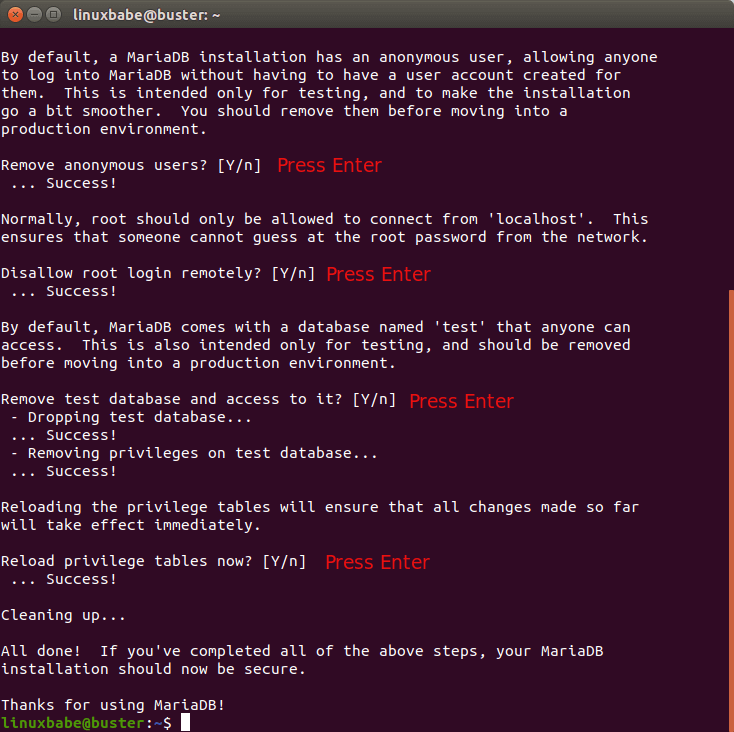
By default, the MaraiDB package on Debian uses unix_socket to authenticate user login, which basically means you can use username and password of the OS to log into MariaDB console. So you can run the following command to login without providing MariaDB root password.
sudo mariadb -u root
or
sudo mysql -u root
To exit, run
exit;
Check MariaDB server version information.
mariadb --version
Output:
mariadb Ver 15.1 Distrib 10.3.15-MariaDB, for debian-linux-gnu (x86_64) using readline 5.2
Step 4: Install PHP7.3 on Debian 10
At the the time of this writing, PHP7.3 is the latest stable version of PHP and has minor performance improvement over previous versions. Enter the following command to install PHP7.3 from Debian 10 repository.
sudo apt install php7.3 libapache2-mod-php7.3 php7.3-mysql php-common php7.3-cli php7.3-common php7.3-json php7.3-opcache php7.3-readline
Enable the Apache php7.3 module then restart Apache Web server.
sudo a2enmod php7.3 sudo systemctl restart apache2
Check PHP version information.
php --version
Output:
PHP 7.3.4-2 (cli) (built: Apr 13 2019 19:05:48) ( NTS )
Copyright (c) 1997-2018 The PHP Group
Zend Engine v3.3.4, Copyright (c) 1998-2018 Zend Technologies
with Zend OPcache v7.3.4-2, Copyright (c) 1999-2018, by Zend Technologies
To test PHP scripts with Apache server, we need to create a info.php file in the Web root directory with a command line text editor, such as Nano.
sudo nano /var/www/html/info.php
Paste the following PHP code into the file.
<?php phpinfo(); ?>
Save and close the file. (To save a file in Nano text editor, press Ctrl+O, then press Enter to confirm. To exit, press Ctrl+X.)
Now in the browser address bar, enter server-ip-address/info.php. Replace sever-ip-address with your actual IP. If you follow this tutorial on your local computer, then type 127.0.0.1/info.php or localhost/info.php.
You should see your server’s PHP information. This means PHP scripts can run properly with Apache web server. You can find that Zend OPcache is enabled.
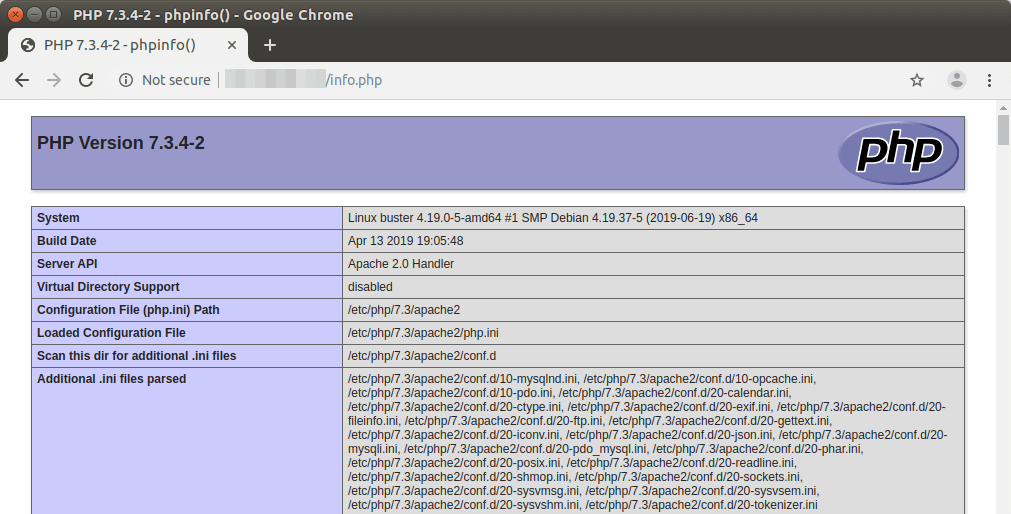
How to Run PHP-FPM with Apache
There are basically two ways to run PHP code with Apache web server:
- Apache PHP module
- PHP-FPM.
In the above steps, the PHP7.3 module is used to handle PHP code, which is usually fine. But in some cases, you need to run PHP code with PHP-FPM instead. Here’s how.
Disable the Apache PHP7.3 module.
sudo a2dismod php7.3
Install PHP-FPM.
sudo apt install php7.3-fpm
Enable proxy_fcgi and setenvif module.
sudo a2enmod proxy_fcgi setenvif
Enable the /etc/apache2/conf-available/php7.3-fpm.conf configuration file.
sudo a2enconf php7.3-fpm
Restart Apache for the changes to take effect.
sudo systemctl restart apache2
Now if you refresh the info.php page in your browser, you will find that Server API is changed to FPM/FastCGI, which means Apache web server will run PHP code with PHP-FPM.
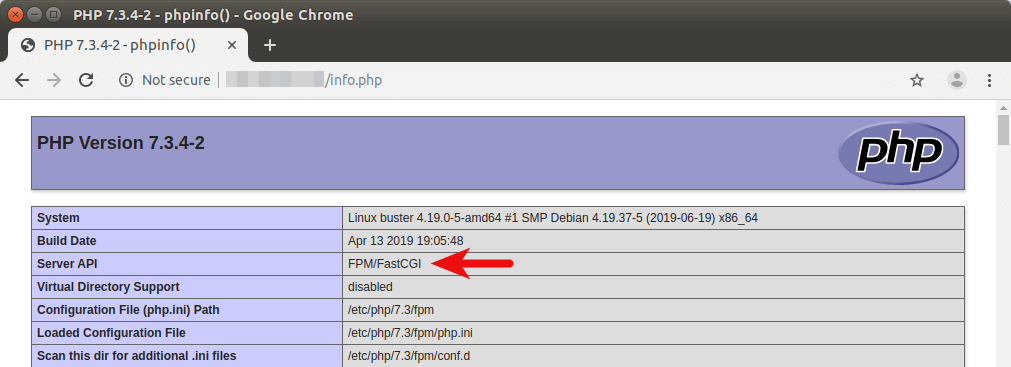
Next Step
Congrats! You have successfully installed Apache, MariaDB and PHP7 on Debian 10 Buster. For your server’s security, you should delete info.php file now to prevent prying eyes.
sudo rm /var/www/html/info.php
I hope this tutorial helped you install LAMP stack on Debian 10 Buster. You may also want to check out the following tutorial to install phpMyAdmin, a web-based MariaDB/MySQL administration tool
As always, if you found this post useful, then subscribe to our free newsletter to get new tutorials.



This is a useful, up to date post, thanks. It might be worth noting that following this will leave you with Apache in prefork, non-threaded mode – not what you want.
If you getting a 503 Error after enabling FPM just restart the fpm service like this:
sudo service php7.3-fpm restart
Why do I see different versions of this document on PC and PI
The last part on my PC is “Next step” and on PI “Wrapping up”
I am confused
Regards
John
Maybe your Pi has a local cache and it’s displaying the old version of web page?
Perfect cut-and-paste install – worked first time, exactly as it should. Thanks!
Great tutorial, a miracle I found it. Everything went smoothly, great result. Looking forward to installing phpmyadmin.